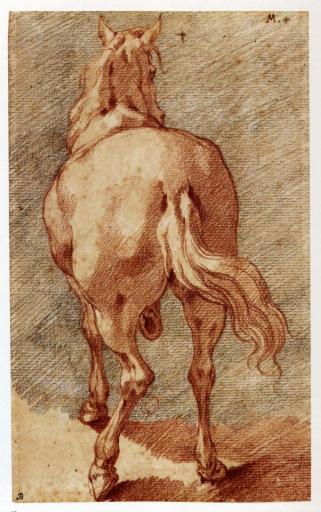Horse Seen from Behind |
|||||||||
|---|---|---|---|---|---|---|---|---|---|
| Primary Creator |
|
||||||||
| Contributor(s) |
|
||||||||
| Properties |
|
||||||||
| Name of Work | Horse Seen from Behind | ||||||||
| Production Date | 1587c | ||||||||
| Production Location |
|
||||||||
| Current Location |
|
||||||||
| Media Types | black chalk, paper, red chalk | ||||||||
| General Notes | |||||||||
Description
Drawing of an active, strong horse, from the rear, with tail swishing and front right leg raised. Strong, accurate, realistic rendering.
Theme
Emotional Sum or Sense-of-life
Not much except perhaps stylistic -- confident, strong drafting style, and a vibrant, alive, horse.
Context Information
Tags

Discussion
- Log in to post comments
Thematic vs. ExperientialThis drawing is instructive in relation to another drawing on ArtGrok "Head of a Bearded Man". While both of these drawings are similar in quality of wonderful draftsmanship, the Horse drawing is Experiential because it has no theme. Whereas the Head of a Bearded Man, by virtue of being a drawing of a face, and given its strong emotional character, falls into the Thematic Art category. This points out that the choice of a painter (draftsman) to do a portrait or face can result in a thematic work by virture of that subject choice, whereas even though the horse can be considered as good, it lacks the emotional sense afforded by a face. The rear end of a horse just doesn't have the expressive potential of a man's elderly face.